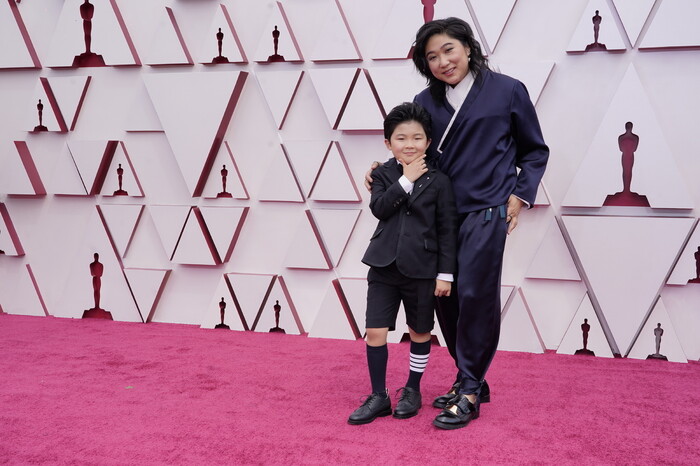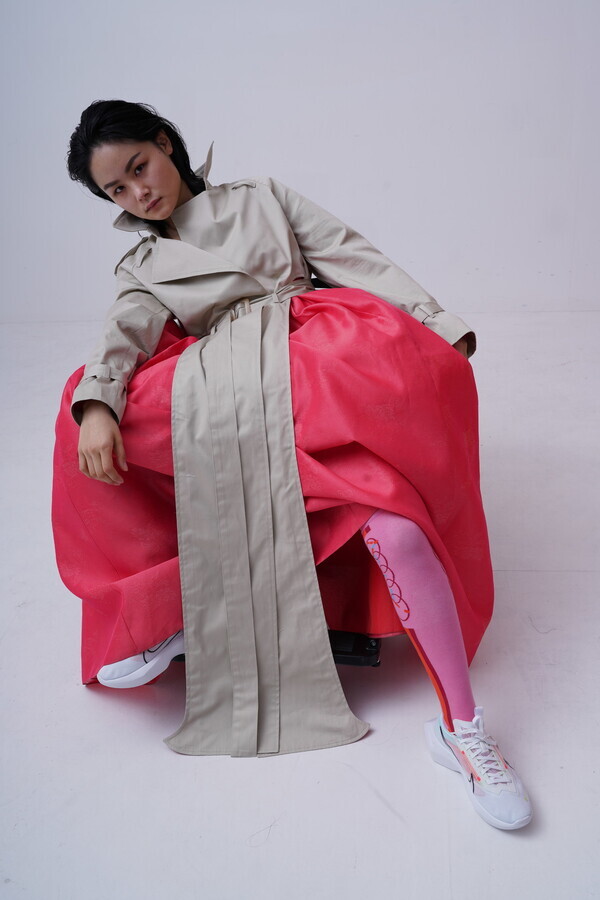hankyoreh
Links to other country sites 다른 나라 사이트 링크
Allure of hanbok grows with boundary-busting transformations
“Modern” takes on traditional Korean clothing gain popularity by blurring differences of gender, ability, and ethnicity

Koreans of all ages remember the experience of taking their bundled traditional hanbok garments out of the wardrobe on holiday mornings.
The first thing we encountered was not the hanbok design — it was the smell of naphthalene, which had been put inside the bundle to keep the moths away.
Since the outfits were only worn on major holidays and other special days, it was rare to find someone who knew how to put one on properly. Family members would argue over whether the knots on the pants’ ankle band should be on the right or left side, or on the inside or outside. Finally, we would give up, flop down like children in front of our grandmother, and stick our ankles out.
In my case, I wore my multicolored hanbok for so many years that the inner lining stuck out from the shirt’s sleeve.
As that era passed, I left hanbok behind. Decades have passed, and I figured that since I wasn’t planning on having a wedding, there wouldn’t be any occasion for me to don one of the outfits again.
We also have a lot more substitutes for naphthalene today, so I rarely encounter that distinctive smell anymore. My memories of hanbok have grown fainter.
But the time has come to start thinking about hanbok once again. Indeed, the outfits are already drawing notice — but these aren’t the hanbok of the past.
Throwing out the hanbok rulebookWhen I look back on the moments when I’ve found myself thinking, “I’d like to wear that,” “That looks fantastic,” “I’m proud of this one,” or “I want one,” they’ve all been styles that broke the rules of past hanbok.
The rigid gender-based clothing distinctions and formalities of the past have been rendered meaningless.
In 2013, designer Kim Young-jin’s sub-brand Tchai Kim got a lot of people talking with its one-piece “cheollik.” A recreation of the clothing worn by military officials in the Joseon Dynasty, it is mentioned even now as an excellent example of a modern spin on hanbok.
In a 2018 Melon Music Awards performance, the members of the group BTS danced barefoot in hanbok outfits with their coat strings untied and their shirt fronts undone. They wore jackets with the hanbok pants as they waved fans. It was a show that let the whole world know how breathtakingly beautiful hanbok can be.
At a red carpet event for the 93rd Academy Awards ceremony in April, “Minari” producer Christina Oh wore a hanbok suit that broke with the traditional formula of women wearing a skirt and blouse when they put on hanbok.

The knots of those ankle bands looked stunning when set against that dignified and easy style. Seeing it brought back my old memories of the last time I had seen those bands.
A month later, singer Jo Kwon took the stage at a fashion show by hanbok wizard Park Sul-nyeo. Beneath his traditional hat (gat) and gentleman’s gown, you could glimpse a red skirt hem and embroidered silk kkotsin shoes with seven-centimeter heels. I was once again taken aback by how well it harmonized as a whole.

Another barrier that has been coming down is the one concerning abilities.
Rising designer Kim Cheong-eum — who recently took home the grand prize in a 2020 hanbok design project competition organized by the South Korean Ministry of Culture, Sports and Tourism and the Hanbok Advancement Center — is currently working on developing Cycloid as Korea’s first barrier-free hanbok brand.
It’s a line of hanbok outfits designed to do away with distinctions between the clothing favored by disabled and non-disabled people. Instead, they are meant to be worn by anyone who finds them appealing. The trenchcoat draws on the form of the dangui — an open-sided upper garment worn by women — while the knots around the knees double as rings for decorations and straps, allowing for easy movement of the legs.
“In college, I had a close friend who used a wheelchair. She saw the leather jacket I was wearing and said it was too bad she couldn’t wear one because it was too awkward for her,” Kim recalled.
“She said that she wanted to wear pretty, flashy clothes, but that she was too shy because of the way people looked at her just because she was in a wheelchair,” she said.
“I decided I wanted to do away with those ideas of ‘disabled’ and ‘non-disabled’ when it comes to clothing and create comfortable clothing that everyone can wear.”
In Korea, the preconception is that hanbok are ceremonial outfits to be worn on specific dates or at specific events; if you break from that, it tends to draw attention. We also see clear distinctions between “male” and “female” outfits.
These ideas have gotten in the way of making hanbok a part of our own lives. But hanbok has evolved to meet the demands of the times, and the changes it is undergoing have been truly dynamic.
That’s why we should be paying attention to the ways the outfits have been transforming — questioning and blurring boundaries or distinctions of gender and ability when it comes to how the outfits should be worn and taking on new forms that are better suited for today.
By Yu Seon-ju, guest reporter
Please direct comments or questions to [english@hani.co.kr]

Editorial・opinion
![[Editorial] Penalties for airing allegations against Korea’s first lady endanger free press [Editorial] Penalties for airing allegations against Korea’s first lady endanger free press](https://flexible.img.hani.co.kr/flexible/normal/500/300/imgdb/original/2024/0502/1817146398095106.jpg) [Editorial] Penalties for airing allegations against Korea’s first lady endanger free press
[Editorial] Penalties for airing allegations against Korea’s first lady endanger free press![[Editorial] Yoon must halt procurement of SM-3 interceptor missiles [Editorial] Yoon must halt procurement of SM-3 interceptor missiles](https://flexible.img.hani.co.kr/flexible/normal/500/300/imgdb/child/2024/0501/17145495551605_1717145495195344.jpg) [Editorial] Yoon must halt procurement of SM-3 interceptor missiles
[Editorial] Yoon must halt procurement of SM-3 interceptor missiles- [Guest essay] Maybe Korea’s rapid population decline is an opportunity, not a crisis
- [Column] Can Yoon steer diplomacy with Russia, China back on track?
- [Column] Season 2 of special prosecutor probe may be coming to Korea soon
- [Column] Park Geun-hye déjà vu in Yoon Suk-yeol
- [Editorial] New weight of N. Korea’s nuclear threats makes dialogue all the more urgent
- [Guest essay] The real reason Korea’s new right wants to dub Rhee a founding father
- [Column] ‘Choson’: Is it time we start referring to N. Korea in its own terms?
- [Editorial] Japan’s rewriting of history with Korea has gone too far
Most viewed articles
- 1Months and months of overdue wages are pushing migrant workers in Korea into debt
- 2[Editorial] Penalties for airing allegations against Korea’s first lady endanger free press
- 3Bills for Itaewon crush inquiry, special counsel probe into Marine’s death pass National Assembly
- 4Trump asks why US would defend Korea, hints at hiking Seoul’s defense cost burden
- 560% of young Koreans see no need to have kids after marriage
- 6S. Korea discusses participation in defense development with AUKUS alliance
- 7[Reporter’s notebook] In Min’s world, she’s the artist — and NewJeans is her art
- 8Korean firms cut costs, work overtime amid global economic uncertainties
- 91 in 3 S. Korean security experts support nuclear armament, CSIS finds
- 10[Guest essay] Maybe Korea’s rapid population decline is an opportunity, not a crisis